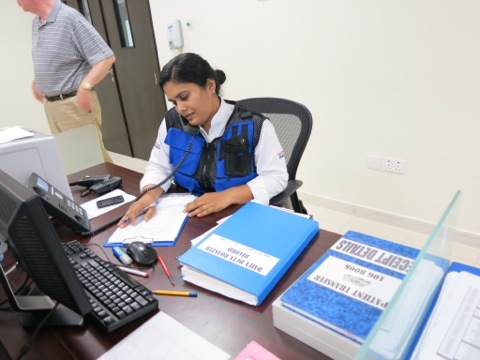EMS & Dispatch Operations in Dubai
Dubai, United Arab Emirates: I’m in Dubai this week to cover the 2012 APCO Global Congress. The Congress doesn’t officially kick off until tomorrow, but the APCO Institute has held two days of training in advance, and Neil Kirby, ambulance operation director for the Dubai Corporation for Ambulance Services, graciously arranged for a site visit for interested delegates. So at 1245 hrs this afternoon, four of us–including APCO International President Gregg Riddle and two representatives from Gold-level sponsor Tait–boarded a bus to the desert.
The ambulance service’s headquarters are about 20 minutes outside of town in the desert. It’s located near the fire service training ground. We passed burn buildings on our way in.
Upon arrival, Kirby gave us a brief presentation on the service’s operations. The mission: To present Dubai as an excellence center in providing ambulance and emergency medical services.
Formed in 2006, the Dubai Corporation for Ambulance Services provides emergency response, patient transfer, events coverage, first aid, first response, AED courses, BLS, ACLS and PALS, as well as paramedic training.
Because this is Dubai, the 700-medic staff is composed primarily of non-native workers. They come mostly from the Philippines, Jordan, India and then the UAE. Many of the medics were nurses, or even doctors, in their home countries before coming to Dubai and receiving their EMT and medic training. Last year, the service handled 88,000 cases, and the medics essentially perform the same skills as nurses do.
There are 57 local Emirate paramedics, trained through the College of Higher Education, with an EMT-P program accredited through the U.S.
In Dubai, 9-9-9 emergency calls, as well as 9-1-1, 2-1-1 and most other emergency numbers dialed, are answered by police calltakers. (All emergency numbers from around the world reroute to 9-9-9.) A police dispatcher then contacts an ambulance driver (not a medic) who responds with a two-medic crew to the emergency. The call is then transferred to a medical dispatcher who collects additional information and offers medical advice while the ambulance is en route. The driver must speak Arabic, and the medics must be able to speak English.
The service operates three dispatch centers, one of which is dedicated to non-emergency transports, and one located at the airport. Dispatchers work six days on, two days off on a rotating shift schedule: two afternoon shifts (1:30 p.m. – 9:30 p.m.), two night shifts (9:30 p.m. – 5:30 a.m.) and two day shifts (5:30 a.m. – 1:30 p.m.).
The local paramedics go through extensive training, a four-year program. Recertification is required and includes AHA, ACLS and PALS courses. They work eight-hour shifts, although Kirby is considering going to longer shifts. The official workweek cannot exceed 48 hours.
The service is largely funded by the government. However, a 300 dirham fee is officially charged for patient transport.
The ambulance fleet comprises Type 1 and Type 2 ambulances, first responder vehicles, desert response, supervisor response, two female-only staffed ambulances (the “Mamas,” which are pink), motorbikes, three buses and more. One of the three buses put the service into the Guinness Book of World Records for being the world’s largest ambulance. One of the three is designed to “stay and play,” one is designed primarily for patient transport, and the third–the largest–can serve both purposes. The largest has ultrasound and X-ray capability and can serve as an operating theater if necessary.
Kirby says the service could put 1157 patients on stretchers in a disaster.
Dubai has two main receiving hospitals, one of which is a trauma center. The protocols are fairly strict to determine which hospital receives which patients.
Although there are 23 additional ambulance providers in Dubai, they are restricted by law from providing emergency transport. Thus, they are relegated mostly to inter-hospital transfers.
Kirby also says that a high percentage of calls result in patient refusals and non-transports.
The site visit proved highly informative and gave me an interesting perspective on the differences between how EMS is typically delivered in the U.S. and how it’s delivered in Dubai. When given the opportunity, as during the 2012 APCO Global Congress, we have much to learn from each other.
Keri Losavio, editor
Public Safety Communications












